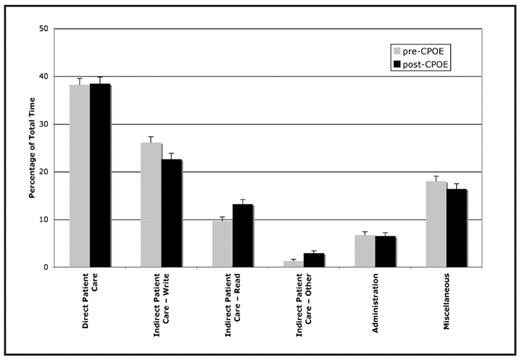Abstract
No data are available concerning the impact of CPOE on inpatient leukemia and lymphoma care. CPOE may improve patient safety, reduce time between order entry and medication administration, and reduce medication and transcription errors. However, concerns have arisen about potential increased time required to enter electronic orders compared to handwritten orders. Our hypothesis was that CPOE would require more order-related time from caregivers, and reduce the amount of time for direct patient care. We studied the work patterns of three Physician Assistants (PAs) who worked under the supervision of faculty physicians, and were the exclusive inpatient care providers. The PA-staffed hematology service was chosen to minimize the impact of rotating house staff on our results. Faculty, who were not studied, entered the few chemotherapy orders necessary, while PAs entered orders for hydration, antibiotics, supportive care and other medications, and for consultations and diagnostic tests. The UMHS Institutional Review Board reviewed the study protocol and waived the requirement for patient informed consent. We performed a direct observation time and motion study pre- and post-implementation of a commercial CPOE system (Sunrise Clinical Manager™ 4.5, Eclipsys, Boca Raton, Florida) on one inpatient hematology service at the UMHS University Hospital. The same three PAs were shadowed pre- and post-implementation. We also closely matched morning and afternoon observation times in order to reduce variability in activities taking place at different times of the day. Prior to CPOE implementation the PAs had a 4 hour general training session and a 1 hour chemotherapy training session. Pre-built order sets were routinely used by the PAs. A portable tablet computer was used by an independent observer to record data, using a data entry interface containing 63 individual activity categories modified from the Time and Motion database under “IT Tools” at http://www.ahrq.gov. Data were grouped into subcategories for analysis. We grouped 12 activities as ordering-related (e.g. writing orders, writing forms, clarifying orders, etc.) We observed the same three PAs for 85.4 hours (over 2 weeks) pre, and for 75.8 hours (over 4 weeks) starting 3 months post-CPOE. Mean patient census was 11.3 per day pre- and 9.2 per day post implementation observation periods. Overall time for order-related activities was unchanged, requiring 7.7% of total time pre- and 8.1% of total time post-CPOE even though actual order writing took longer with CPOE compared to written (4.9% pre vs. 7.0% post). CPOE had almost no impact on direct patient care time (Figure), with PAs spending 38.2% total time on direct patient care pre-CPOE compared to 38.4% post. A minimal difference was also found with the overall total for indirect patient care activities (37.1% pre vs. 38.7% post). Our results suggest that using CPOE on a busy hematology inpatient service has minimal impact on time spent by trained PAs using standard order sets 3 months after implementation. The decision to adopt CPOE for a busy hematology service should not be based on the hypothesis that there will be a change in workflow or task organization. More study is needed to determine if CPOE for hematology patients results in a change in the quality of patient care or safety.
Percentage of total time spent in 6 analysis categories both before and after implementation of a commercial CPOE system for an inpatient hematology service. These 6 categories represent 63 individual activities categories that were recorded in the time and motion study. Error bars represent 95% confidence intervals.
Percentage of total time spent in 6 analysis categories both before and after implementation of a commercial CPOE system for an inpatient hematology service. These 6 categories represent 63 individual activities categories that were recorded in the time and motion study. Error bars represent 95% confidence intervals.
Disclosures: No relevant conflicts of interest to declare.
Author notes
Corresponding author


This feature is available to Subscribers Only
Sign In or Create an Account Close Modal